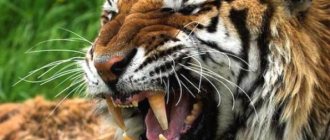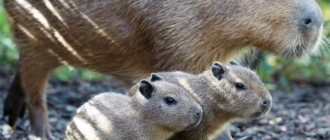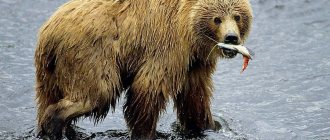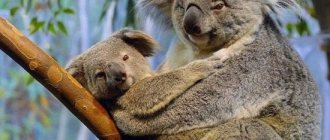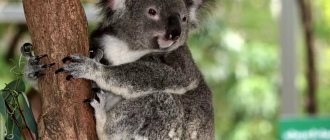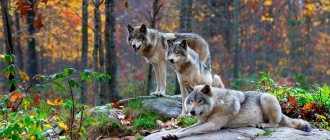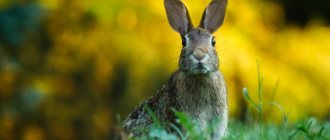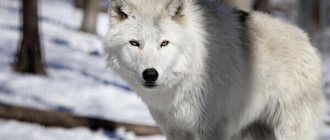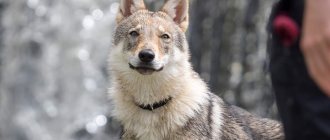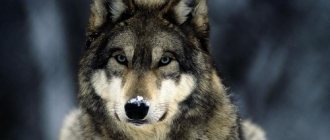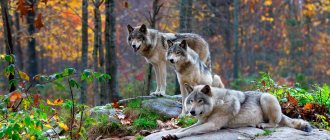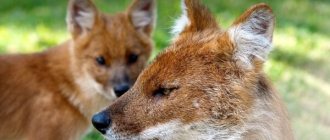Description of the animal
This predator appeared as a result of crossing gray wolves with coyotes. Therefore, it is intermediate in size between these two animals.
What does it look like
The body length of an adult is just over a meter, the average weight varies from 12 to 20 kilograms. Males, unlike females, are much larger and more powerful. Representatives of canine predators have strong muscles and a dense, elastic physique; they are similar in appearance to foxes, and in ears to jackals.
This type of wolf differs from its relatives in its special coat color. The fur is red in color with a copper tint. The color of the coat sometimes changes - it depends on the age and region of residence.
The predator's muzzle is thin and elongated with small eyes. At the top of the head are ears that are rounded upward. Unlike gray wolves, this individual has fewer molars, but a large number of nipples.
Character and lifestyle
Red wolves do not live separately; they gather in small packs. All members of the community have family ties. The most dominant pair is at the head of the pack. All other members of the group are their offspring. The size of the flock generally does not exceed twelve adult individuals.
Most often, there are no more than two dozen predators in a group. When there are a lot of animals, the flock splits into two.
In a group, aggression towards each other does not manifest itself, but when a stranger appears, they are treated with caution and often show unfriendliness.
They hunt more often during daylight hours. All mature individuals participate in the search for food. Predators have several methods of hunting.
They attract ungulate mammals with certain sounds, and then pursue the prey in a line. There is another strategy when individuals distribute roles. One part of the flock pursues prey, and the second intercepts it during the chase.
What does it eat?
The red wolf is a common predator, so the main source of food is small wild ungulate mammals, and they also pick up carrion.
It happens that individuals choose a large animal, in which case they hunt in a pack. They pursue a potential victim exclusively during the daytime, driving him into the water, where the animal will become more vulnerable to attack.
It is known that in the summer, the diet of wolves includes food of plant origin, in particular, green mountain rhubarb. Females feed their offspring with this plant. To do this, they regurgitate semi-digested inflorescences and feed the puppies with this.
Where does it live?
The predator lives in a wide variety of areas. This could be the mountain foothills of a peak, coniferous forests or cedar thickets.
Thick layers of snow or deep snowdrifts are unacceptable to wolves, as this makes it difficult to hunt game, so they look for other habitats. However, regardless of their natural habitat, they need shallow snow cover for full life.
These animals are not sedentary and move long distances in search of food. This type of canine is found in Indonesia, India, Tibet, China, Mongolia and the islands of Sumatra and Java. In Russia, it can be found in the coniferous forests of Eastern Siberia.
Reproduction
Red wolves are famous for their constancy and devotion to the family. A male and a female form a family and mutually feed their offspring.
Puppies are born all year round. If you follow the statistics, offspring appear more often in winter or early spring. The she-wolf bears her offspring for two months.
Puppies are born blind in the amount of 6-8 pieces. Their appearance is reminiscent of baby German Shepherds. After two weeks, the puppies begin to see. At the age of three months, the wolf cubs begin to gradually leave the den.
Puppies begin to immediately learn the habits of adults. Having reached the age of eight months, they are allowed to participate in general hunting. They reach sexual maturity by the age of one year.
Natural enemies
Particularly dangerous for the red wolf are its relatives - the gray wolf and coyote. In defending the territory, they exterminated red wolves, as a result of which the latter found themselves on the verge of extinction.
Natural enemies include lynxes and snow leopards. They are also willing to kill animals to avoid competition in order to provide themselves with food.
Humans and their activities pose an important danger to predators. The hunt for the animal was carried out on a large scale. People set up massive ambushes and made ingenious traps to kill the beast for meat, skins and fur.
Red wolves have a different set of sounds from ordinary ones when communicating with each other. Their howl resembles a melodic drawn-out singing.
Common jackal
This small animal is also called “bark san”. The jackal is found in South Asia, however, not so long ago, it was widespread in some European countries, for example, in Albania. The jackal is very similar to a dog. It's smaller than, say, a dingo, or even a standard mongrel.
Its body weight is much less than that of the gray wolf, up to 20 kg. The jackal's muzzle is pointed and oblong, like a fox's. The fur of this "reduced wolf" is brownish-gray in color. In winter it becomes smoother. During the day, Kora San almost never eats, choosing to eat in the evening. He eats:
- Fish;
- Bird;
- Carrion;
- Snails;
- Frogs;
- Bugs;
- Berries;
- Snakes, etc.
It turns out that the jackal is practically omnivorous. He rarely hunts with his own kind. Despite its small size and lack of wolf endurance, a sharp mind and dexterity help the jackal to be a good hunter. It can silently sneak up on its prey and easily grab it before it can escape.
Red wolf in the Red Book
In 1996, the predator was included in the list of the International Union for Conservation of Nature as a canid species in danger of extinction.
Main causes of extinction
Diseases such as plague and rabies contribute to a sharp reduction in the number of individuals. These diseases progressed quickly and were transmitted to healthy animals, causing mass deaths.
Human development of untouched natural places also contributed to the extinction of animals. People also exterminated predators, believing that they attacked livestock. Although in fact, red wolves did not do this, unlike their gray relatives.
Large animals - leopards, tigers, coyotes, pumas - also contributed to the decline of this canine species. Predators attacked red wolves in order to secure hunting territory for themselves.
Current population situation
As of 2012, there were no more than 300 red individuals in the world, of which 207 lived in captivity, including in the zoo. Nowadays the situation has not changed much.
The thing is that in the North Carolina nature reserve the number of individuals is unstable. The population either increases or decreases.
In this regard, it is very difficult to make accurate forecasts for the future, and even more so, poachers are still hunting in the wild. Therefore, it is impossible to give a definite answer about the further fate of these individuals.
What measures are taken to protect
To preserve the species of the animal, it was included in the Red Book of the Russian Federation and the IUCN Red Book. It has been given endangered species status. Catching and hunting for it is strictly prohibited; violation of this requirement will result in criminal penalties.
In order to increase the population, the habitat areas of the predator are being studied, and a ban is being placed on human development of these territories. The number of ungulates in this area is also increasing to feed red wolves.
In the wild, the lifespan of this type of animal is 8 years, and in captivity – 14 years.
Reproduction
Female wolves become sexually mature in the second year of life, males in the third, mating season for wolves usually occurs from January to April. There are frequent fights for a female between competing males, as well as mutual courtship and flirting of both males and females.
During mating, “loving” wolves leave the pack, retire, setting up a den in a secluded place. A she-wolf's pregnancy lasts 62-65 days and from 3 to 13 cubs are born at a time. True, not all of them survive; the weaker wolf cubs die.
Little wolf cubs feed on milk and burps from their mother, and after just six months of life they become able to take part in hunting.
Interesting facts about the animal
The red wolf can be seen on the one ruble coin issued in 2005. And on the Kazakh coin of five hundred tenge, as well as on the Kazakh postage stamp.
For the most part, the animal lives in India; it is there that a reserve has been created, where under a license you can legally hunt this predator.
Three adults can eat a large deer whole in three minutes, and in a pack they can easily knock down an adult tiger. In 1939, about 800 individuals were exterminated in Texas.
The red wolf is a beautiful and unique animal. But many people are unaware of its existence due to its disappearance. Therefore, work is being carried out in the regions where individuals live in order to explain to the public that this species has a protected status.
Hunting and food
The basis of their diet is large ungulates: moose, deer, saigas, sheep, they also feed on muskrats, rabbits, raccoons or rodents, and sometimes eat berries, insects, and carrion. The red wolf may hunt alone or with other members of its family, preferably in the evening or at night. In turn, they can also become victims of other large predators: red lynxes or alligators, which attack especially young members of the pack.
Their characteristic feature is the storage of food. After the animals are satisfied, they bury the remaining pieces of meat in the ground. Most likely, they do not remember the exact location, but they remember the area where the victim was eaten or killed.
Habitats
Wolves live in a variety of natural zones: tundra, forest-tundra, steppe, forest-steppe, semi-deserts, avoiding dense forests. It can settle in the mountains, from the foot to the alpine meadow zone. A wolf can settle near human habitation. In the taiga, the wolf spread after humans, as taiga forests were cut down.
Wolves make dens for breeding; for this they most often use natural shelters: crevices in rocks, thickets of bushes, overgrown ravines. Wolves can occupy the burrows of badgers, marmots, arctic foxes and other animals. Wolves themselves dig holes extremely rarely. The female is most attached to the den when raising wolf cubs; the male is not attached to the den. As soon as the wolf cubs grow up, the wolves stop using the den. Wolves never hunt near their den, but hunt at a distance of at least 7-10 kilometers from it.
How does a leader rule?
A pack of wolves unconditionally accepts the leadership of the leader. He dominates the males, and his girlfriend keeps order among the she-wolves. The leader never tires of reminding his subordinates who is the boss in the pack - he growls at them, bites them, even knocks them down, doing this in front of the whole family.
As a rule, one close and stern look from the leader or his wolf is enough for those he targets to submit. Grinning, and rather ingratiatingly, the wolves fall to the ground, and then, if they succeed, stealthily leave the place of punishment. Sometimes they lie on their backs, as if to say: “We agree that you are the most important.”
An interesting fact about wolves - the position of a predator in a pack can be judged by the way it holds its tail. The leader always has it raised high. For ordinary “subjects” it is omitted. And those individuals who are at the lowest level in the pack tuck their tails between their legs.
Family members show their love and respect for the leader and his mate in a welcoming ceremony. With ears flattened, crawling and fur smoothed, they crawl up to them, lick and gently nibble their faces.
Wolf's Lair
The wolf's hole is quite simple. As a rule, it has one entrance. In the forest-steppe regions of Siberia, they have a depth of about four meters, the entrance diameter is about 50 cm.
In Transbaikalia, researchers observed how wolves dig tarbagan holes in the fall, and in the spring they discovered wolf litters in them. One of these holes was more than five meters long, forty centimeters wide and twenty-five centimeters high. The nest inside the hole was half filled with dry grass bedding. It contained tarbagan skins.
In the Far North, these predators build burrows along the banks of streams and rivers. In these areas, the soil is well drained and there is no permafrost, so it is easy to dig a hole.
Many holes can be found near the summer pastures of deer. As a rule, wolves wander behind herds of these animals. Before the puppies appear, they move forward, closer to their burrows, where the deer also come, but a little later.
Video
And in conclusion, we invite you to watch an interesting film about wolves from the National Geographic channel - “The Rise of the Black Wolf.”
Author: Pavel Chaika, editor-in-chief of Poznavaika magazine
When writing the article, I tried to make it as interesting, useful and high-quality as possible. I would be grateful for any feedback and constructive criticism in the form of comments on the article. You can also write your wish/question/suggestion to my email [email protected] or Facebook, with respect, the author.
Author page
Lifestyle
Wolves are animals that prefer to live in families. Any pack of wolves has its own “charter”, in which everyone has their own role. Aggressive and strong young people rule, and those who need a firm hand obey them.
A wolf pack, in which the animals are related, is led by a wolf and a she-wolf. The rest of its members, mainly their offspring (from very stupid puppies to 3-year-old teenagers), obey them. Sometimes strangers join the flock, having left their flock for some reason. Typically, up to 15 animals live in such a family.
